
Christ Church St Kilda: the western façade
[(photograph by John Maidment (10 April 2006)]

Christ Church St Kilda: the western façade
[(photograph by John Maidment (10 April 2006)]
Historical and Technical Documentation by John Maidment
© OHTA, 2008, 2012 (last updated June 2013)
Christ Church is St Kilda's earliest surviving church building. The first sections, designed by [Albert] Purchas (1825-1899) & [Charles] Swyer (1825-1876), were built between 1854 and 1857, with enlargements taking place in 1874 and 1881 to the design of Sydney W. Smith.1 This cruciform building, constructed from Point King, Sorrento sandstone is in a massive Decorated Gothic style.
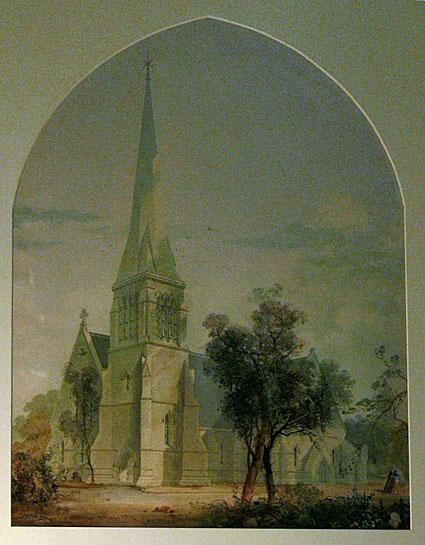
Architects' realisation of the completed west front,
with tower and spire, from Christ Church St Kilda archives,
courtesy Fr Jim Minchin
(photograph by John Maidment (25 February 2008))]
The western façade incorporates a distinctive triangular rose window, possibly inspired by medieval examples at Lichfield, and the stump of a tower and broach spire (with doorways opening east and west) which would have been highly impressive, had it been completed. On the side walls of the transepts are unused stair turrets for galleries which have been long been demolished. The southern parapet of the nave is adorned with delightful carvings of Gothic ornament and mythical beasts, some adapted as rain water spouts.
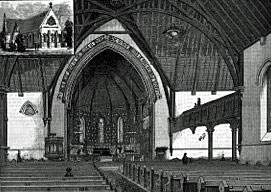
Christ Church, St Kilda : interior from Australasian Sketcher (1 July 1882)
The spacious interior focuses upon the brilliantly stencilled walls of the chancel and sanctuary whose floor is paved in black and white marble. The stained glass is of great excellence including examples of the work of Melbourne artists Ferguson & Urie, glowing with colour, William Montgomery and Brooks Robinson together with London artist W.C. Taylor.2
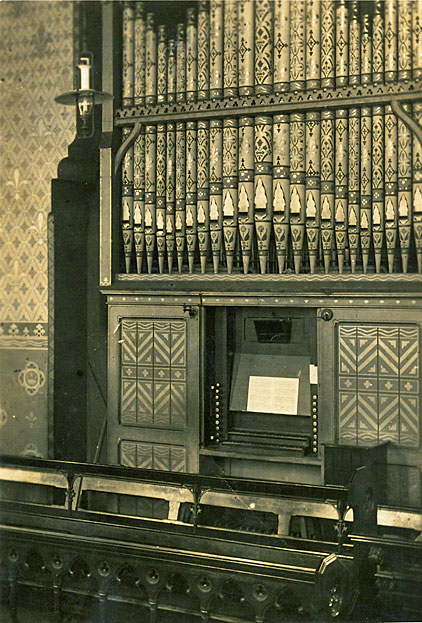
The 1859 Hill & Son organ from a photograph taken c.1909-1916
showing the original console, façade pipe and case decoration
(photograph from the Martin family album with the caption
"Here is seen the Organ which the late Judge Molesworth endowed"
[courtesy Stephen Baldwin and the Vestry of Christ Church, St Kilda])
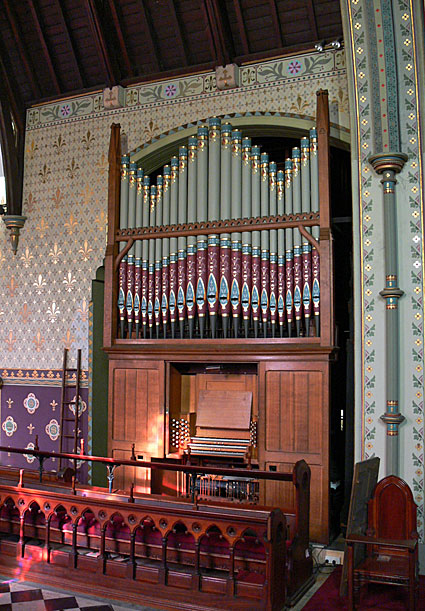
The 1859 Hill & Son organ, now located in the south chancel,
showing façade pipes redecorated 2008 by Marc Nobel
[photograph by John Maidment (17 June 2009)]
The organ in this church is the earliest authenticated example of a church organ sent to Australia by the noted London firm of Hill & Son, the firm's job number 1025 and costing £420.3 Built in 1859, it was opened on 29 January 1860.4
The only earlier identifiable instrument sent to Australia by the firm was a two-manual chamber organ built for the residence of Peter Davis in the preceding year – this instrument is now at St Peter's Lutheran Church, Stawell. The Hill firm was to export 40 instruments to Australia before its amalgamation with Norman & Beard Ltd in 1916. The Great Organ was identical to that provided for the 1866 Hill & Son organ installed in the Independent Church, Collins Street, Melbourne. The oak casework resembles a drawing provided by William Butterfield for the book Instrumenta Ecclesiastica edited by the Ecclesiological Society and published in 1847.
| GREAT ORGAN Open Diapason Stopped Diapason Dulciana Principal Flute Twelfth Fifteenth Sesquialtera Trumpet [Swell to Great] SWELL ORGAN Double Stopped Diapason Open Diapason Stopped Diapason Principal Cornopean PEDAL ORGAN Open Wood (small) [Great to Pedal] |
8 8 8 4 4 2-2/3 2 3 ranks 8 16 8 8 4 8 16 |
* TC (to Tenor C) |
* not mentioned on original order but clearly provided at this time
Compass: 54/42/27
Oak case
complete in shop £320 (10%) [probably commission]5
The instrument was originally placed on a gallery at the west end of the church before the completion of the transepts, chancel and organ chamber.
In 1874 George Fincham provided an estimate for additions, alterations and removal of organ at Christ Church, St Kilda:
The present Tenor C sound-board to Swell Organ to be taken away and replaced with new double C soundboard (the ends top and back of present swell box to be reused in its construction of swl box for new soundboard whose new Venetian front double lined + the edging buffed with felt or baize.
* The stops on Swell now terminating at Ten C to be carried down to Double C with new pipes, viz-
| Double Dia Open Dia Stop Dia Principal Horn Piccolo 'prepared for' |
CC to CC to CC to CC to CC to CC to |
5 5 5 5 5 5 |
16ft tone 8ft 8ft 4ft 8ft 2ft |
(If the Piccolo is ordered within the 12 mths the cost not to exceed £10-0.0)To be added new coupler swell to pedals – The bellows action to be altered from its present position at side of organ to the back to suit new chamber.
The organ to be taken down, carefully cleaned.
* All action required to connect double return of swell keys to soundboard to be supplied.
Action &c repaired and where necessary rebushed.
To be erected in new chamber carefully regulated and tuned.
The above to be executed for the sum of one hundred pounds £100-0-0 to be paid as funds will allow, the balance to be paid within 12 mths of completion.
19 August 1874 George Fincham, Organ Builder6
In 1910 George Fincham & Son extended the pedal compass by three notes, this including additional pipes for the Open Diapason, action, soundboard and completed the compass of the two pedal couplers. A tremulant and Oboe were added to the Swell Organ.7 It is uncertain when the Pedal Bourdon was added – as there is no mention of this in 1910, it possibly was a later addition.
In 1916 there was a major rebuilding by the Melbourne firm of Meadway & Slatterie, of Crossley Street, Melbourne.8 Edward P. Meadway was an English organbuilder trained with Norman & Beard Ltd who emigrated to Melbourne in 1912 to install the new organs at St Peter's Anglican Church, Eastern Hill and the Chapel of St Peter, Melbourne Grammar School.9 He was also an expert reed voicer and in 1921 assisted in lowering the pitch of the Melbourne Town Hall organ10 and returned to England in 1924. J.W. (Jack) Slatterie was apprenticed to George Fincham from c.1880 and left in 1894 to gain experience overseas, working in London with Hill & Son.11 This work was carried out to a very high level of competence. The previous mechanical action was converted to pressure tubular-pneumatic, a new attached drawstop console in oak provided and a Choir Organ of four stops added on the east wall of the chamber, together with other minor changes noted below. The instrument was reopened on 29 April 1917.
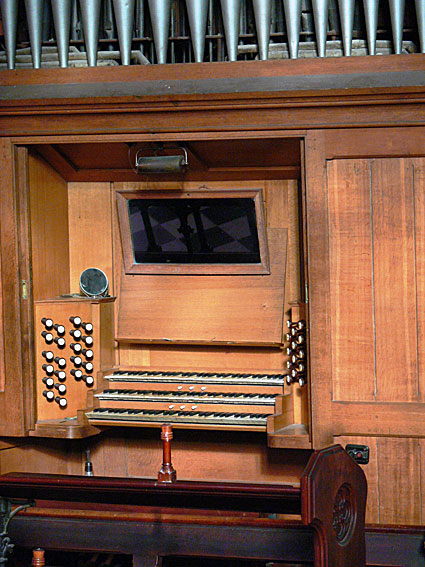
The 1916 oak console by Meadway & Slatterie before addition
of extra drawstops by Stewart Organs
[photograph by John Maidment (10 April 2006)]
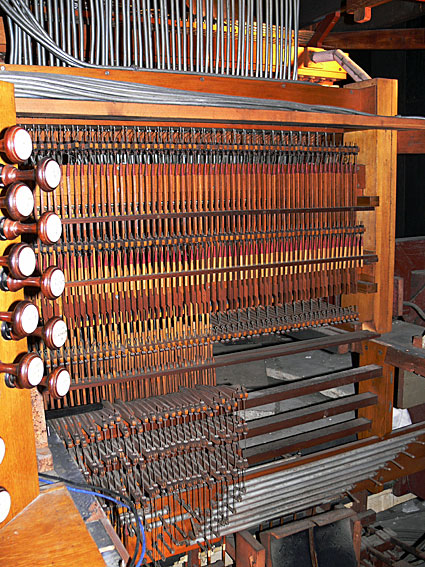
The 1916 pneumatic touch boxes by Meadway & Slatterie
behind the console after the start of the restoration by Stewart Organs
[photograph by John Maidment (28 July 2006)]
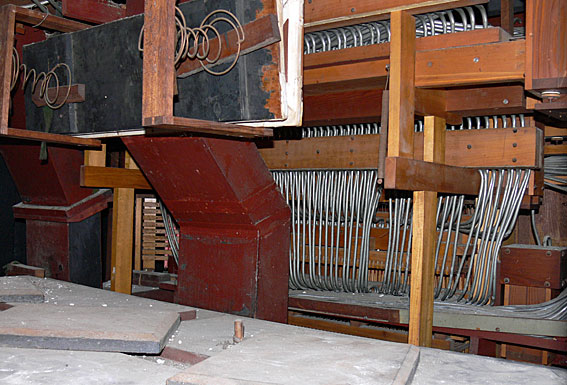
The 1916 tubular-pneumatic action by Meadway & Slatterie
before restoration by Stewart Organs
[photograph by John Maidment (10 April 2006)]
The 1916 specification follows:
| GREAT ORGAN Open Diapason Hohl Flute Stopped Diapason8 Dulciana Principal Wald Flute Fifteenth Mixture Trumpet Swell to Great Choir to Great SWELL ORGAN Bourdon Open Diapason Stopped Diapason Echo Gamba Voix Celeste Octave Piccolo Horn Oboe Tremulant Swell Sub Octave Swell Unison Off Swell Octave CHOIR ORGAN Violin Diapason Leib.Gedact Flute Clarionet Swell to Choir PEDAL ORGAN Open Diapason Bourdon Principal Bass Flute Great to Pedal Swell to Pedal Choir to Pedal |
8 8 8 8 4 4 2 [III] 8 16 8 8 8 8 4 2 8 8 8 8 4 8 16 16 8 8 |
1916: on Twelfth slide revised to 19.22.26 1978 Laurie Pipe Organs 1916: on rear chest: zinc bass TC 1916: on rear chest Fincham 1910: on clamp Fincham 1910 (enclosed) all 1916 zinc bass wood: pierced stoppers in treble wood bass stopped metal treble A B: 1916? A 1916 B 1916 |
Compass: 61/30 (Great and Swell have top note machines f# - c)
Pressure tubular pneumatic action
Mechanical manual to pedal coupling
Balanced mechanical swell pedals to swell and choir12
The instrument received a thorough restoration by Stewart Organs (Ken Falconer) that began in 2006 and was completed in 2013. The 1916 tubular pneumatic actions have been entirely preserved and fitted with new leather and felts. The large double-rise reservoir and slider chests have all been carefully restored by Peter D.G. Jewkes Pty Ltd. The manual keyboards have been recovered in ivory resin by P&S in England. The 1859 Twelfth has been replaced on the Great Organ with new pipes closely matched to the original and the 1916 Hohl Flute placed in storage. A Mixture of four ranks has been added to the Swell on the Cornopean slide (the Cornopean being placed on a clamp) and a 42-note Trombone unit added to the pedal on tubular-pneumatic action using pipework scaled along Hill & Son lines supplied by Terry Shires and voiced by David Frostick in the UK. The Great and Swell windchests and the main building frame have been moved forward to assist with tonal egress and to allow space for the addition of the Trombone. This has also involved the extension of the lead pneumatic tube runs to the Choir Organ, which remains in its original position.
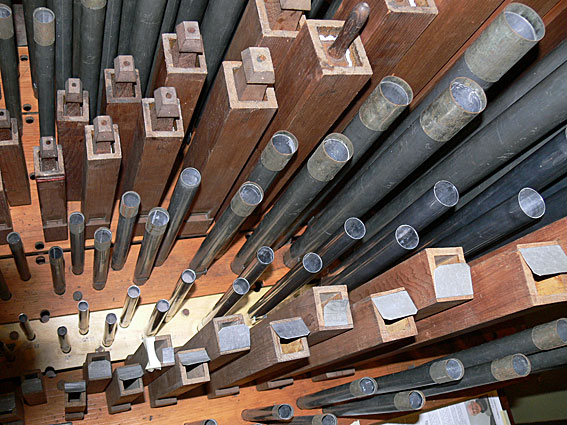
The Hill & Son Great pipework, showing the wooden Stopped Diapason,
with drilled stoppers, and the reconstructed cone-tuned Twelfth,
after restoration by Stewart Organs
[photograph by John Maidment (5 March 2009)]
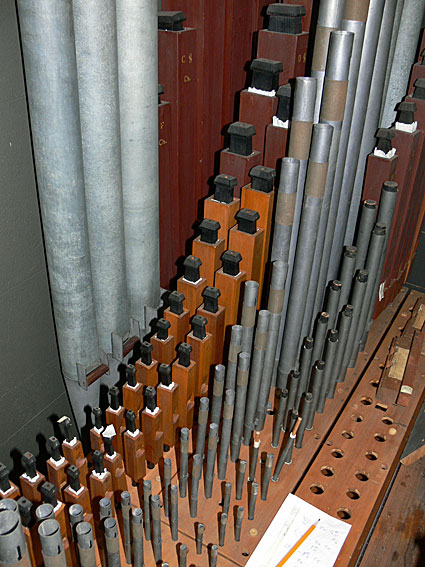
The Meadway & Slatterie Choir pipework, showing the wooden Lieblich Gedeckt,
with drilled stoppers, the slotted Violin Diapason, and the Lieblich Flöte 4
(Clarionet not yet installed), after restoration by Stewart Organs
[photograph by John Maidment (5 March 2009)]
Marc Nobel restencilled the façade pipes with brilliant effect in 2008. It was not possible to recreate the earliest patterns which had been overpainted several times and most recently, in 1916 it is believed, with silver frost.13
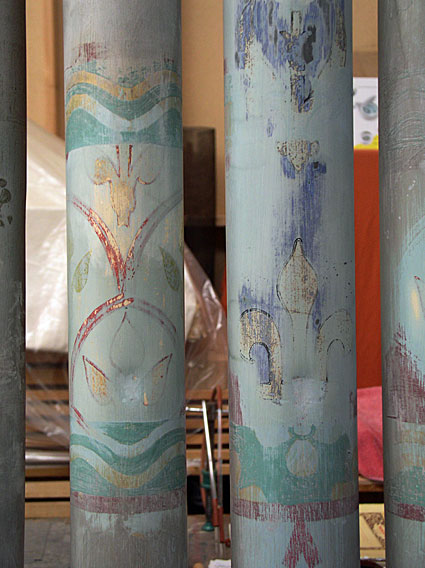
Patterns found on the façade pipes during their redecoration by Marc Nobel 2008 –
the blue pattern, with fleur de lys, appears to be the original design
[photograph by John Maidment (22 September 2008)]
| GREAT ORGAN Open Diapason Stopped Diapason Dulciana Principal Wald Flute Twelfth Fifteenth Sesquialtera 17.19.22 Trumpet Swell to Great Choir to Great Sub Octave SWELL ORGAN Bourdon Open Diapason Stopped Diapason Echo Gamba Voix Celeste Octave Piccolo Mixture 15.22.26.29 Cornopean Oboe Tremulant Swell Sub Octave Swell Unison Off Swell Octave CHOIR ORGAN Violin Diapason Lieblich Gedeckt Lieblich Flöte Clarionet Swell to Choir PEDAL ORGAN Open Diapason Bourdon Principal Bass Flute Trombone Trumpet Great to Pedal Swell to Pedal Choir to Pedal |
8 8 8 4 4 3 2 III 8 16 8 8 8 8 4 2 IV 8 8 8 8 4 8 16 16 8 8 16 8 |
gvd bass SO 2008 (originally unison) M&S 1916 slotted, zinc bass, on additional rear chest TC M&S 1916 slotted, on additional rear chest Fincham c.1874 – wood SO 2008 on Cornopean slide on new clamp Fincham 1910 on clamp Fincham 1910 (enclosed) all M&S 1916 zinc bass slotted treble wood with drilled stoppers wood bass, metal treble with cork stoppers (recycled 1859 Hill & Son Twelfth from TC up) A B M&S 1916? A M&S 1916 B M&S 1916 C SO 2008 C SO 2008 (mechanical) (mechanical) (mechanical) |
Compass: 61/30 (Great and Swell have seven-note top note machines)
3 thumb pistons to Great
3 thumb pistons to Swell
3 composition pedals to Great
3 composition pedals to Swell
Great to Pedal reversible pedal
Balanced mechanical swell pedals to Swell and Choir
1. Victorian Churches, edited by Miles Lewis. East Melbourne: National Trust of Australia (Victoria), 1991, p. 83
2. Ibid.
3. Hill & Son estimate book vol 1, p.374 (housed in British Organ Archive, Birmingham Central Library). The instrument is also mentioned in the List of the Principal Organs built by Messrs. Wm. Hill & Son, of York Road, Camden Road, London, N. during the last 30 years, p.4.
4. Argus, 28 January 1860, p. 5
5. Hill & Son order books
6. George Fincham & Sons letter books, 1/84-85
7. George Fincham & Sons letter books, 22 31 May 1910
8. Pers.comm. The Revd Philip Hutchinson (Vicar) to John Maidment c.1978 from church minute books
9. The Freeman-Edmonds Directory of British Organ Builders, edited by David Wickens. Oxford: Positif Press, 2002, vol. 3, p.615
10. Pers. comm. Simon Purtell to John Maidment February 2008
11. George Fincham & Sons letter book, 9/157, 9 June 1894; Matthews, p.98
12. Specification noted John Maidment 1966
13. Details of restoration noted John Maidment 2008